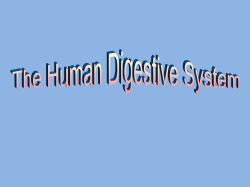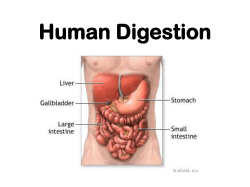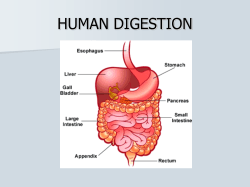
Reticulum Honeycomb lining Formation of food bolus
Reticulum Honeycomb lining No secretions Formation of food bolus Regurgitation initiated here Collects hardware (nails, wire) Rumen Digestion and fermentation vat Contains anaerobic microbes (25-50 billion bacteria/mL fluid) Also protozoa, fungi Produce VFA, protein Papillae lining 40-50 gallons No secretions Increase surface area Absorption of VFA Passive diffusion Omasum Laminae/manyply lining Reduces particle size Absorption of water Muscular folds No secretions ~60% removed Absorption of VFAs ~2/3 of VFAs entering or 10% of total produced Prevents buffering of the abomasum Abomasum True gastric stomach - four gallons in a cow Three regions (cardiac, fundic, and pyloric) Digestive secretions Proteolytic enzymes and HCl pH decreases from 6 to 2.5 Denatures proteins Kills bacteria and pathogens Dissolves minerals Gastric digestion Small Intestine Composed of 3 segments (proximal to distal) Duodenum Jejunum Releases bile and pancreatic secretions Active site of digestion Active site of nutrient absorption Ileum Active site of nutrient absorption Most water, vitamins & minerals Some bacterial presence Fermentation The pH of the small intestine increases towards 7.0 as food moves from the duodenum to the ileum Intestinal Epithelial Cell Brush border Specialized Cells Lining Villi Nutrients Mucus Absorptive epithelial cell Contain brush border on lumen/apical side Brush border: Enzymes Nutrient transport molecules Goblet cell Secretes mucus Specialized Cells Lining Villi Anti-microbial compounds Endocrine cell Paneth cell CCK, Secretin, etc. Secrete hormones into bloodstream or local cells Secretory granules with anti-microbial properties Small Intestine – Absorptive Surface Villi Enterocyte Brush border Cell migration from crypts to tips of villus 2-3 days Small Intestine - Structure Lumen Mucosa Villi Crypts Lacteal Enterocyte Brush border Intestinal Wall Villi Mucosa Enhanced Surface Area for Increased Nutrient Absorption Intestinal villi Increased Surface Area in Small Intestine for Absorption Structure Description Increase in surface area Plicae circularis Regular ridges in small intestine 3x Villi Finger-like projections on mucosal (inner) surface 1 um projections on surface of epithelium 10x Microvilli Brush Border 20x Nutrient Absorption in the Small Intestine Principal site of absorption of amino acids, vitamins, minerals and lipids Generally, most absorption occurs in the proximal (upper) part of the small intestine but some absorption occurs in all segments Glucose and other sugars in monogastrics Duodenum, jejunum and ileum Digestion and absorption within SI is rapid Within 30 minutes of entering SI Nutrient Absorption Variety of mechanisms Diffusion Facilitated diffusion Active transport Pinocytosis or endocytosis Dependent upon Solubility of the nutrient (fat vs. water) Concentration or electrical gradient Size of the molecule to be absorbed Diffusion Water and small lipid molecules pass freely through membrane Move down concentration gradient to equalize concentrations Facilitated Diffusion 1) Carrier loads particle on outside of cell 2) Carrier releases particle on inside of cell 3) Reverse Allows equalization of concentrations across membrane Active Transport 1) Carrier loads particle on outside of cell 2) Carrier releases particle on inside of cell 3) Carrier returns to outside to pick up another particle Active Transport Unidirectional movement Transports nutrients against concentration gradient Pinocytosis or Endocytosis Substance contacts cell membrane Membrane wraps around or engulfs substance into sac Sac formed separates from the membrane and moves into cell Transporters Secretions Entering SI Intestinal mucus Brush border enzymes Pancreatic juices Produced & stored in pancreas Bile Secreted from within SI Produced in liver Stored in gallbladder Horse has no gallbladder Enters from ducts into SI Direct bile secretion into duodenum Cannot store bile—continuous intake of food Intestinal Mucus Secreted by glands in wall of duodenum Brunner’s glands Acts as lubricant and buffer to protect duodenal wall Primary Enzymes for Carbohydrates Nutrient Enzyme Origin Product Starch, glycogen, dextrin Amylase Saliva & pancreas Maltose & Glucose Maltose Maltase SI Glucose Lactose Lactase SI Glucose & galactose Sucrose Sucrase SI Glucose & fructose Primary Enzymes for Proteins Nutrient Enzyme Origin Product Milk protein Rennin Gastric mucosa Curd Proteins Pepsin Gastric mucosa Polypeptide Trypsin Chymotrypsin Pancreas Pancreas Peptides Peptides Carboxypeptidase Aminopeptidase Pancreas Small intestine Peptides & amino acids Polypeptides Peptides Primary Enzymes for Lipids Nutrient Lipids Enzyme Origin Product Lipase & colipase Pancreas Monoglycerides & free fatty acids Bile Green, viscous liquid Secreted by liver via bile duct to duodenum Stored in gall bladder (except in horses) Functions to emulsify fats Composition Alkaline ph (neutralize acidic chyme) Bile salts (glycocholic and taurocholic acids) Bile pigments (bilirubin and biliverdin) Cholesterol 95% reabsorbed and returned to liver NOT AN ENZYME Nutrient Digestion - Lipids Large Lipid Droplet Small Action of bile salts Lipid emulsion Bile salts & pancreatic lipase and colipase Water soluble micelles Pancreatic Juice Clear, watery juice Enters duodenum via pancreatic duct Aids in fat, starch, and protein digestion Contains HCO3Trypsinogen ProChymotrypsinogen enzymes Procarboxypeptidase Amylase Lipase Nuclease Importance of Pancreas for Digestion Produces enzymes responsible for 50% of carbohydrate digestion 50% of protein digestion 90% of lipid digestion Produces sodium bicarbonate for neutralization of chyme in duodenum Activation of Pancreatic Enzymes Enterokinase Secreted from crypts in duodenum Trypsinogen trypsin Trypsin then converts: Trypsinogen trypsin Chymotrypsinogen chymotrypsin Procarboxypeptidase carboxypeptidase Overview of Digestive Enzymes Stomach Pepsinogen Chymosin (rennin) Pancreas Trypsinogen Chymotrypsinogen Procarboxypeptidase Amylase Lipase Nuclease Brush Border (SI) Sucrase Maltase Lactase Aminopeptidase Dipeptidase Enterokinase Ruminant Small Intestine Similar in structure and function to monogastric Differences are subtle but important Limited ability to digest starches and sugars Little to none presented except in exceptional circumstances (high-grain feeding) Small Intestine Digesta pH Duodenum 2.7 - 4 Jejunum 4–7 Ileum 7-8 Functions Enzymes pH change Flow rate regulation Enzymes Absorption Absorption Limited fermentation Rate of pH increase through small intestine is slower than monogastrics Better for peptic activity May limit pancreatic protease and amylolytic activity Pancreatic Secretions Secretion pH is 7.2-7.8 Enzymes Amylase Lipase Proteases Trypsinogen converted to trypsin Chymotrypsinogen converted to chymotrypsin Procarboxypeptidase converted to carboxypeptidase Nucleases Activity of Pancreatic Enzymes Concentration of enzymes in pancreatic juice comparable to monogastrics Activity is lower and may be affected by: Less juice secreted/kg BW Low digesta pH High rate of passage Limited activity particularly a problem for intestinal digestion of starch escaping ruminal digestion For ruminants fed high grain diets, less than 50% of starch reaching small intestine is digested Bile Secreted with pancreatic juice in the common bile duct of sheep Secreted in the bile duct of cattle Large Intestine Composed of three segments Cecum Colon Rectum Function Fermentative digestion No enzyme secretion Relies on microbes or secretions washed out of the SI Absorption of remaining water, volatile fatty acids (VFAs) from microbial fermentation and minerals Digesta storage Degree of development is species dependent Monogastric Cecum Located at junction of small and large intestine Function similar to rumen in ruminants Microbial activity and digestion of feeds Contains a microbial population similar to the rumen Cellulolytic & hemicelluloytic bacteria Since cecum is located AFTER major site of nutrient absorption (small intestine), then microbial cell proteins are not available to the animal Fecal loss Monogastric Large Intestine Function: Absorption of liquid Mass movements move fecal matter to anus Usually only a few times a day Associated with defecation Bacteria Cellulolytic – digest cellulose (forages) Amylolytic – digest starches and sugars (concentrates or grains) Other types: Proteolytic Clostridium Organic acid utilizers Methanogens Produce CO2, H2, formate, CH4 Ruminant Large Intestine Fermentative digestion Bacteria similar to rumen, but no protozoa Digestion in colon may account for as much as: Only important in conditions that increase the amount of fermentative carbohydrate entering the large intestine 27% of cellulose digestion 40% of hemicellulose digestion 10% of starch digestion Increased rate of passage of forages High grain diets May account for as much as 17% of total VFA absorption VFAs are efficiently absorbed, but primarily used as energy source for large intestinal mucosa cells Ruminant Large Intestine Absorption of ammonia-N May account for as much as 30 to 40% of the net transport of N into body fluid Absorbed N may be used for: Synthesis of nonessential amino acids Recycling of N to the rumen Regulated by: Important on low protein diets Increased by increasing N concentration of diet Decreased by increasing the amount of carbohydrate fermented in the large intestine Mineral absorption Water absorption 90% of water entering the LI is absorbed Rectum Muscular area of large intestine used for storage of feces and ultimately for defecation Feces includes sloughed cells, undigested food and microbial matter Digestive Adaptations to Varying Feed Sources Gastric capacity and structure Capacity is greatest in pregastric fermentors Stomach acts as reservoir Small stomach in carnivores is related to high nutrient density of the diet Distribution and composition of epithelial lining varies between species and dietary adaptations Digestive Adaptations to Varying Feed Sources Intestinal length and functions Small intestine Less variable among species than stomach and hind gut, but generally shorter in carnivores than in herbivores Large intestine Importance of hind gut fermentation dictates variation in structure and size Some hind gut fermentation occurs in most species Adaptations of the Digestive Tracts Stomach Small Intestine Cecum Large Intestine Rule Size = Function Adaptations of Digestive Enzymes Young animals produce little sucrase, maltase, amylase Ruminants produce no sucrase Adult pigs lack lactase Activity changes with age Lactase Sucrase, maltase Utilizing Cellulose Advantages Ultra-abundant in the environment Easily obtained – no need to “hunt” plants Plant cell walls & fiber high in energy Disadvantages Indigestible by mammalian digestive enzymes Cellulase is found only in bacteria & some protozoans Fermentative Digestion All mammals have some fermentative capacity that allows for utilization of ingested fiber The comparative importance of fermentation is related to the fraction of total digesta contained in fermentative compartments of the gastrointestinal (GI) tract Advantages of Pregastric Fermentation Make better use of alternative nutrients Ability to detoxify some poisonous compounds Oxalates, cyanide, alkaloids More effective use of fermentation endproducts Cellulose Nonprotein nitrogen Volatile fatty acids, microbial protein, B vitamins Allows wild animals to eat and run Disadvantages of Pregastric Fermentation Fermentation is inefficient Energy Loss % of total caloric value Methane 5-8 Heat of fermentation 5-6 Relative efficiency is dependent on the diet NDF Protein Some ammonia resulting from microbial degradation will be absorbed and excreted 20% of the nitrogen in microbes is in the form of nucleic acids Disadvantages of Pregastric Fermentation Ruminants are susceptible to ketosis Ruminants are susceptible to toxins produced by rumen microbes Nitrates to nitrites Urea to ammonia Nonstructural carbohydrates to lactic acid Tryptophan to 3-methyl indole Isoflavonoid estrogens to estrogen coumestans Pregastric Fermenters Class Ruminants Nonruminants Species Dietary habit Cattle, sheep Grazing herbivores Deer, antelope, camel Selective herbivores, including folivores and frugivores Colobine monkey, hamster, vole Selective herbivores Kangaroo, hippo Grazing and selective herbivores Hoatzin Folivore Postgastric Fermentors Cecal fermentors Mainly rodents, rabbits and other small herbivores Often associated with coprophagy Colonic fermentors Includes true herbivores (e.g., horse), omnivores (e.g., pig and human), and carnivores (e.g., cat and dog) Horse has some expanded cecal fermentation in addition to greatly expanded colonic fermentation Degree of colonic sacculation is related to importance of fiber digestion and fermentative capacity Postgastric Fermenters Class Cecal digesters Species Capybara Rabbit Rat, mouse Colonic digesters Sacculated Elephant, horse, zebra New World monkeys Pig, human Unsacculated Panda Dog, cat Dietary habit Grazer Selective herbivores Omnivores Grazers Folivores Omnivores Herbivores Carnivore Foregut vs. Hindgut Fermentation Foregut More efficient per unit volume of food Slower digestive process Animal may starve with a full belly Size restricted Hindgut More efficient relative to time Faster turnover Feeding Habits of Mammals & Taxonomic Distribution Feeding Habit Number of Orders Herbivory Frugivory, Graniv., Nectivory Carnivory Planktonivory? (Krill feeders) Insectivory Omnivory 10 5 4 2 10 7 Percent of Species 40 4 12 <1 33 10 Classification of Animals by Preferred Ingested Feedstuffs Carnivore – consume animal products Herbivore – consume plant products dogs, cats komodo dragon, tigers, eagles, sharks, polar bear cattle, sheep, goats, horses giant panda, gorilla, elephant, ostrich, green iguana, giraffe, American bison Omnivore – plant and(or) animal products pigs opossum, raccoon, blue jays, black bear, human Specialized Carnivores Aphidivore - feeds on aphids Apivore - feeds on bees Erucivore - feeds on caterpillars Insectivore - feeds on insects Larvivore - feeds on larvae Myrmevore - feeds on ants Mucivore - feeds on flies Piscivore - feeds on fish Pupivore - feeds on pupae Ranivore - feeds on frogs Sanguivore - feeds on blood Zoosuccivore - feeds on liquid animal secretions of decaying animal matter Specialized Herbivores Ambivore - feeds on grasses and broad leaf plants Exudativore - feeds on gums, resins, and sap Folivore - feeds on foliage (leaves or trees) Forbivore - feeds on forbs (i.e. flowering plants) Frugivore - feeds on fruit Graminivore - feeds on grasses Granivore - feeds on grains Gumivore - feeds on gums secreted by some plants Lignivore - feeds on wood Mellivore - feeds on honey Nectarivore - feeds on nectar Nucivore - feeds on nuts (agouti) Phytisuccivore - feeds on (tree) sap Radicivore - feeds on roots Classification by Type of Digestion or Site of Digestion Monogastrics or non-ruminants Ruminants OR Pre-gastric fermentation (cranial) Post-gastric fermentation (caudal) Monogastric Animals Single, simple stomach structure Mostly carnivores and omnivores Very simple - mink, cat and dog Cecal digestion - horse, rabbit, elephant or rat Sacculated stomach - kangaroo Ruminant Animals Ruminant – herbivores possessing multiple digestive tract compartments for feed breakdown before feed reaches the “true” stomach True ruminants - cattle, sheep, goats Pseudo-ruminants - camels, llamas, alpacas, vicunas A GIT Capacity - Volume Carnivores Omnivores stomach (70%) > SI = LI (15%) GIT surface/body surface: 0.6:1 stomach = SI = LI (33%) GIT surface/body surface: intermediate Herbivores Ruminants stomach (70%) > SI (20%) > LI (10%) GIT surface/body surface: 3:1 Non-ruminants stomach (10%) < SI (30%) < LI (60%) GIT surface/body surface: 2:1 GIT Classifications - Dog Monogastric carnivore with limited post-gastric fermentation Simple stomach, not capable of effective utilization of forage-based (high fiber) diets Unable to digest some of the substances in grains, fruits and vegetables Similar to cat GIT Classifications - Pig Monogastric omnivore with limited post-gastric fermentation Simple stomach, not capable of effective utilization of forage-based (high fiber) diets Unable to digest some of the substances in grains, fruits and vegetables Similar to human Pig _________________________________________ Stomach (2 gal) Large Intestine (16’, 2 gal) Esophagus Mouth Cecum (10”, 0.5 gal) Small intestine (60’, 2.5 gal) Human Digestive Tract Rat GIT Classifications - Kangaroo Monogastric omnivore with limited pre-gastric fermentation Sacculated stomach,capable of utilization of foragebased (high fiber) diets Able to digest some of the substances in grains, fruits and vegetables GIT Classifications - Horse Monogastric herbivore with extensive postgastric fermentation Simple stomach incapable of utilization of foragebased (high fiber) diets Extensive fermentation after primary sites of digestion and absorption Horse _________________________________________ Small Colon (12’, 3 gal) Small intestine (70’, 12 gal) Esophagus Large Colon (12’, 19 gal) Mouth Cecum (4’, 8 gal) Stomach (3.5 gal) GIT Classifications - Sheep Ruminant herbivore with extensive pre-gastric fermentation Highly developed sacculated stomach capable of extensive and effective utilization of forage-based (high fiber) diets Extensive fermentation before primary sites of digestion and absorption Similar to cattle and goats Cow _________________________________________ Large intestine (33’, 8 gal) Cecum (3’, 3 gal) Esophagus Rumen (paunch) (43 gal) Mouth Small intestine (150’, 16 gal) Abomasum (glandular) (5 gal) Reticulum (honeycomb) (2.5 gal) Omasum (4 gal) GIT Classifications Avian is modified monogastric Beaks replace lips and teeth Crop (enlarged area of esophagus) stores and softens feed prior to entering stomach Proventriculus – glandular stomach Gizzard – muscular part of stomach Branched cecum –postgastric fermentation Cloaca – both fecal and urinary waste Uric acid rather than urea (insoluble) Avians (Poultry) Mouth No teeth, rigid tongue Poorly developed salivary glands Saliva contains amylase Beak is adapted for prehension and mastication Avians (Poultry) Esophagus Enlarged area called crop Ingesta holding and moistening Location for breakdown of carbohydrate by amylase Fermentation Proventriculus (stomach) Release of HCl and pepsin (gastric juices) Ingesta passes through very quickly (14 seconds) Avians (Poultry) Gizzard (ventriculus) Muscular area with a hardened lining reduces particle size Muscular contractions every 20-30 seconds Includes action of grit HCl and pepsin secreted in proventriculus Small intestine Similar to other monogastrics No Lacteals Avians (Poultry) Ceca and large intestine Contain two ceca instead of one as in other monogastrics Large intestine is very short (2-4 in) and empties into cloaca where fecal material will be voided via the vent Water resorption Fiber fermentation by bacteria H2O soluble vitamin synthesis by bacteria Chicken Beak Esophagus Crop (2”) Small Intestine (55”) Proventriculus Gizzard (2”) Pancreas Ceca (7”) Large Intestine (4”) Cloaca Feeding Behaviors Impact feed choices Neophobia (avoidance of new feed sources) Contact testing (based on taste and other sensory information collected in mouth) prior to swallowing Early introduction of a variety of feeds limits this problem Chimpanzees select feeds based on easily digestible carbohydrate content (sugars and starches) rather than fat or protein content Grazers and browser select early growth grasses and plants vs. mature growth In confinement feeding situations, grazers consume concentrates first and then forages in ration based on particle size (basis for creating “total mixed rations”) Feeding Behaviors Impact feed intake (avoiding under- and over-consumption of feed) Hiding feed in bear exhibit encourages search and gather behaviors, limiting intake and reducing the stress of captivity Predator behavior towards “prey” meals vs. “bowl” meals Grazing animals prefer to eat forage at ground level rather than in elevated feed bunks
© Copyright 2025











